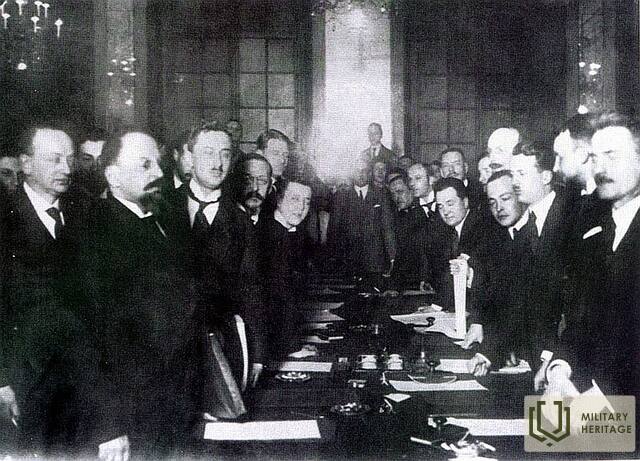Latvian–Soviet Peace Treaty
I World War I, I Wars of Independence

On January 30, 1920, after the liberation of Latgale from the Red Army, Latvia and Soviet Russia concluded a secret armistice. The Latvian side had insisted on the secrecy of the agreement in order not to create unnecessary complications with its ally Poland, which had fought a serious war with Russia in 1920. Peace negotiations could not be kept secret and they began in Moscow on April 16, 1920. Exactly a year earlier, the Germans had staged a coup in Liepāja, reducing the jurisdiction of the Latvian government to the deck of one ship (the “Saratov”) and a few parishes in Northern Vidzeme. A year later, Latvia was liberated and its government could talk to the leadership of mighty Soviet Russia as a victor. Russia was also interested in concluding peace as soon as possible, so that it could concentrate all its forces against Poland and against the anti-tsarist army led by General Wrangel in the Crimea. It seems that the biggest opponents of the peace talks were the Latvian Bolsheviks who had fled to Russia, who dreamed of the possibility of reconquering Latvia, but the peace concluded between the two countries would put an end to this dream.
The Latvian delegation in the peace negotiations with Russia was led by the social democrat Jānis Vesmanis. The delegation also included Pēteris Berģis, Ansis Buševics, Eduards Kalniņš and Kārlis Pauļuks. The peace negotiations were conducted in six commissions: military, political, legal, concessions, financial and re-evacuation. In July 1920, the negotiations moved from Moscow to Riga. After long and complicated negotiations, on August 11, 1920, both sides signed a peace treaty. On the part of Soviet Russia, the peace treaty was signed by Ā. Jofe and J. Gaņeckis.
The peace treaty consisted of 23 articles. In the second paragraph of the treaty, Russia recognized the independence of Latvia and “voluntarily and forever” renounced “all sovereign rights (..) to the people and land of Latvia”. The peace treaty was ratified quickly and with unprecedented unanimity by the Constituent Assembly on September 2. Not a single vote was against. The principles that determine the basis of interstate relations between Latvia and Russia, which are rooted in the peace treaty signed by both countries on August 11, 1920, are still in force. After the conclusion of the Peace Treaty, the demarcation of the border in nature continued. The description of the border with surveys was completed in 1923. The conclusion of the peace treaty with Latvia also meant that Russia recognized Latvia’s independence de iure. This was the basis for the Supreme Council of the Entente powers (the victorious powers in World War I) to recognize Latvia de iure on January 26, 1920.
More information sources
https://www.dveseluputenis.lv/lv/laika-skala/notikums/127/miera-ligums-ar-padomju-krieviju-neatkaribas-kara-noslegums/
https://lvportals.lv/norises/318780-gadsimts-kops-latvijas-un-padomju-krievijas-miera-liguma-parakstisanas-2020






